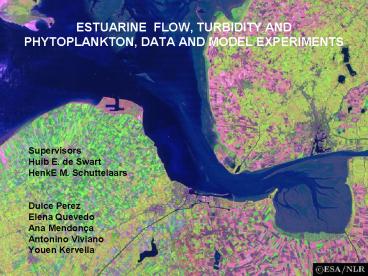ESTUARINE FLOW, TURBIDITY AND PHYTOPLANKTON, DATA AND MODEL EXPERIMENTS - PowerPoint PPT Presentation
1 / 26
Title:
ESTUARINE FLOW, TURBIDITY AND PHYTOPLANKTON, DATA AND MODEL EXPERIMENTS
Description:
advection. diffusion. temporal. variation. Sediment Module. Vertical balance ... advection terms. Where denotes the specific growth rate of the phytoplankton ... – PowerPoint PPT presentation
Number of Views:169
Avg rating:3.0/5.0
Title: ESTUARINE FLOW, TURBIDITY AND PHYTOPLANKTON, DATA AND MODEL EXPERIMENTS
1
ESTUARINE FLOW, TURBIDITY AND PHYTOPLANKTON,
DATA AND MODEL EXPERIMENTS
- Supervisors
- Huib E. de Swart
- HenkE M. Schuttelaars
- Dulce Perez
- Elena Quevedo
- Ana Mendonça
- Antonino Viviano
- Youen Kervella
2
Outline
- Introduction
- Field observations
- Numerical model
- Circulation module
- Suspended sediment module
- Phytoplankton module
- Model results (sensitivity analysis)
- Conclusions
3
Introduction
- Objectives and Approach
- Study of a well mixed estuary, to understand
formation of phytoplankton blooms and compare
results qualitatively with EMS estuary. - The growth rate is a function of
- - Nutrient availability N
- - Ligth intensity I
Hydrodynamic module u, w (x-dir,z-dir)
Sediment transport module (concentration -
turbidity maxima, settling velocity)
Phytoplankton module (nutrients for phyto growth)
4
Introduction
Initial growth of phytoplankton using a linear
stability analysis Initial state no
phytoplankton Predict in which conditions
phytoplankton will grow
5
Introduction
- Analysed Processes
- Hydrodynamics
- Tidal averaged model (effects of tide in mixing
parameters) - Fresh water discharge (q) ? horizontal salinity
gradient ?density-driven circulation - Sediment transport
Sediment suspension (transported and eroded)
Currents
Large bottom shear stresses
Convergence/divergence of sediment transport
Assumption Considering no net sediment transport
(no deposit/erosion of bottom sediments) and
sediment conservation on the upper surface
6
Real Case The Ems Estuary
7
ETM (350-400)
River
Sea
8
Fluorescence Measurements
9
Circulation Module
- Domain
- two-dimensional (x,z)
- depth and width are constant
- x increase toward the river
- z is positive upward
z
x
river q lt 0
sea
h
- Assumptions
- steady-state
- neglected nonlinear terms
- hydrostatic pressure
- laterally homogeneous estuary
- Boussinesq approximation
- mixing coefficient Av is constant (related with
tide) - linear equation of state r ro (1 b S )
10
Circulation Module
- Equations
- in which
- - u, w are horizontal and vertical velocity
- - p is the pressure (hydrostatic)
Salinity distribution is a data of the problem
11
Circulation Module
- If river flow q ? 0, this is the velocity
pattern
sea
river
There will be a point near the bottom in which
u 0 namely STAGNATION POINT
Near this point Turbidity Maxima region is
expected (ETM)
12
Suspended Sediment Module
- HYPOTHESIS
- Sediment does not affect water density
- Sediment does not influence hydrodynamics
- Ws is constant ? Constant grain size
13
Sediment Module
- Processes that affect sediment transport
- Settling velocity
- Advection
- Diffusion
- Sediment conservation equation
advection
diffusion
temporal variation
14
Sediment Module
- Steady motion, at the first order of magnitude
diffusion
advection
temporal variation
Vertical balance settling velocity vertical
diffusion
15
Sediment Module
- Boundary conditions
- No flux through the free surface nor through the
bottom
Solution Vertical concentration profile
Now we need to solve Cb(x)
Cb
16
Sediment Module
- Horizontal problem Integrated equation
- The flux of sediment across each section must
vanish - Integral condition
Y
Concentration
River side
Sea side
X-direction
17
(No Transcript)
18
Linear Stability Analysis
- Basic state P0 0 (no growth)
- Small perturbation P P exp(?t)
- if ?gt0 eigenfunction increase so the
phytoplankton will grow
19
Model Results
20
(No Transcript)
21
Sensitivity analysis
- Allows salt to intrude farther up the estuary.
- Greater landward migration of turbidity maxima.
small
discharge (q)
- Increase in stratification and strength the
estuary circulation. - Increase in the magnitude of the vertical
velocity. - Seaward displacement of the turbidity maxima.
large
- Decrease in the estuary circulation.
- Seaward displacement of the turbidity maxima.
small
water depth (h)
- Strength the estuary circulation.
- Landward displacement of the turbidity maxima.
large
- More suspended sediment in the water column.
small
settling velocity (ws)
large
- More deposition.
22
Tide influence
Av Eddy viscosity coefficient m2/s kz
Vertical eddy diffusion coefficient m2/s
Spring tide
Av 0.002 m2/s kz 0.002 m2/s
23
(No Transcript)
24
Tide influence
Av Eddy viscosity coefficient m2/s kz
Vertical eddy diffusion coefficient m2/s
Neap tide
Av 0.0005 m2/s kz 0.0005 m2/s
25
(No Transcript)
26
Maximum bottom concentration in domain five
times more sediment in the water
27
Conclusions
- Knowledge of ETM and distribution of nutrients
can predict the spatial distribution of
phytoplankton blooms - Maximum growth at the seaside of the ETM since
the river side is light limited and the seaside
nutrient limited - Parameters sensitivity can be easily explored and
understood using these simplified models































